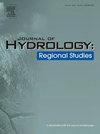对基于事件的径流系数变异性的短期和长期控制分析
IF 5
2区 地球科学
Q1 WATER RESOURCES
引用次数: 0
摘要
研究重点径流系数在水文学中至关重要,它表明了降雨与径流之间的关系。了解径流系数的控制和变化对水资源评估、管理策略和土地利用规划至关重要。本研究利用北美陆地数据同化系统第二阶段(NLDAS-2)马赛克地表模型中 2000-2020 年的数据,研究了俄亥俄地区径流系数的影响因素及其变化趋势。分析考虑了短期控制因素,如气候特征(降雨强度、降雨量和持续时间)、水文因素(先期土壤湿度、排水密度和曲线数)、地形因素(排水面积、土地利用、坡度、海拔)和流域形状。此外,该研究还调查了径流系数的变化趋势及其长期控制因素,包括气候因素和土地利用变化。海拔越高,径流系数越低,这是由于使用了林地。较大的流域在降雨强度较低时径流系数较低,但在降雨强度较高时径流系数较高。长期趋势表明,土壤湿度是主要的控制因素,而土地覆盖的变化是次要因素。这项研究加深了人们对俄亥俄地区径流系数动态和控制的理解。未来的研究可以探讨城市化、水库、蒸散和融雪对径流系数的影响。本文章由计算机程序翻译,如有差异,请以英文原文为准。
Analysis of short- and long-term controls on the variability of event-based runoff coefficient
Study region
This study focuses on the Ohio Region, which spans 11 states in the eastern United States.
Study focus
Runoff coefficients are crucial in hydrology, indicating the relationship between rainfall and runoff. Understanding their controls and variability is essential for water resource assessment, management strategies, and land use planning. This research examines factors influencing runoff coefficients and their trends in the Ohio region using data from the North American Land Data Assimilation System phase-2 (NLDAS-2) Mosaic Land Surface Model, covering 2000–2020. The analysis considers short-term controls, such as climatic features (rainfall intensity, amount, and duration), hydrological factors (antecedent soil moisture, drainage density, and curve number), topographic factors (drainage area, land use, slope, elevation), and watershed shape. Additionally, the study investigates trends in runoff coefficients and their long-term controls, including climatic factors and land use changes.
New hydrological insights for the region
The findings indicate that runoff coefficients increase with antecedent soil moisture and rainfall intensity. Higher elevations show lower runoff coefficients due to forested land use. Larger watersheds have lower runoff coefficients at low rainfall intensity but higher ones when intensity is high. Long-term trends reveal soil moisture as the primary control, with land cover changes as a secondary factor. This research deepens understanding of runoff coefficient dynamics and controls in the Ohio region. Future studies could explore the impacts of urbanization, reservoirs, evapotranspiration, and snowmelt on runoff coefficients.
求助全文
通过发布文献求助,成功后即可免费获取论文全文。
去求助
来源期刊

Journal of Hydrology-Regional Studies
Earth and Planetary Sciences-Earth and Planetary Sciences (miscellaneous)
CiteScore
6.70
自引率
8.50%
发文量
284
审稿时长
60 days
期刊介绍:
Journal of Hydrology: Regional Studies publishes original research papers enhancing the science of hydrology and aiming at region-specific problems, past and future conditions, analysis, review and solutions. The journal particularly welcomes research papers that deliver new insights into region-specific hydrological processes and responses to changing conditions, as well as contributions that incorporate interdisciplinarity and translational science.
 求助内容:
求助内容: 应助结果提醒方式:
应助结果提醒方式:


